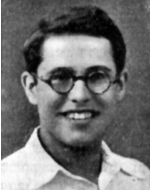Novick, Nacham
Was born in the Borochov neighborhood of Givatayim on the seventh of Passover in 1830. He was a very well-developed young man, strong and strong, who could always stand up for himself and the principle of justice. Joined the “Noar Haoved” movement and joined the movement and its ideas. Nacham studied at the Max Payne Professional School and excelled in the electrical profession. He had good hearing and musical perception, and even conducted the school orchestra. At the same time, he helped his father with work and devoted himself to training at the “HaNoar HaOved” branch in the neighborhood. Was one of the pillars of the branch. Coordinated most of the activities and guided two groups. He participated in the organization of the choir and the dramatic circle and played key roles in the plays. He began to organize a brass band. Was admired by all his apprentices. He did not force his opinion on them. He always knew how to explain and let the trainees choose their way. In December 1947, immediately after the UN General Assembly resolution on the partition of the country and the outbreak of the War of Independence, he was recruited to the local Haganah and served in a combat unit in the vicinity of Tel Aviv. He participated in the battles of Tel Litvinsky, Hiriya and Sakia. Was one of Selma’s first conquerors. At the time of the occupation, he was 18 years old and his commander gave him a short vacation to this day, with the addition of “Shai,” the symbol of the occupied village, and at every moment he came to the Hanoar Haoved branch in the neighborhood, met with his apprentices and spoke with them. Arab, Tantura, etc. He demanded that he be transferred to the Palmach, his comrades from the hachshara, and was not deterred by the use of escape and “desertion” in order to achieve his will. In the end he moved to the Palmach’s first battalion, the “Haemek” battalion in the “Yiftach” brigade, took part in Operation Yiftach, fought the Malkiya and al-Kubab, and the messages were delivered in a quiet voice that conveyed confidence in the tense atmosphere. I was shocked, “he said to his friend,” now I have already acquired the gray feeling of an old soldier. “But at the sight of the enemy’s fiery fields he also felt a sense of comfort, And wanted to pass a winning course and set up an orchestra and a choir in the farm where he would live, but he was a man of toil, and he knew how to put out a Yaffa and perfect work. The problems of society, socialism and socialist Zionism in “Labor, Defense and Peace” saw the goals of the Jewish people and demanded that the youth of Eretz Israel be the pioneering pioneering nucleus, go to the Negev and the border settlements and serve as a civilian corps. During the first truce, he participated in the training conference at Beit Hashita and was one of the most prominent spokesmen of the organization, and fought in the 10-day battles of Operation Danny, the conquest of Lod, Ramle and the nearby villages of Anaba, Daniel and Jimzo. The “Haemek” battalion established Shilta and controlled the eastern part of the Korikor ridge in order to threaten the wing of the Legion Blatter regiment Estate. In the morning it became clear that the Legion force was holding the western part of the ridge. The enemy attacked the force in the outpost from two directions with the aid of armored vehicles, and that was forced to withdraw. In the harsh retreat in an open area under crossfire, many of the fighters fell. In this battle Naham fell on the 11th of Tammuz 5708 (18.7.1948). When Rao-Manu’el, Kalman, was injured and dying, unable to save him, despite an explicit order to withdraw. He carried on with all his strength even after he himself was wounded, until both fell. On the 11th of Adar 5711 (28.2.1950) he was laid to rest in the military cemetery at Mount Herzl in Jerusalem.
